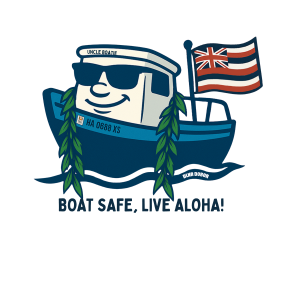IF YOU FIND MARINE DEBRIS OFFSHORE
Posted on Feb 25, 2022 in Announcements, Boat Harbors, Commercial Activities, Fishing Activities, Information Meeting, Main, Ocean Recreation ActivitiesThank you for visiting this post. It means you are interested in helping to keep our ocean waters clear of non-natural debris and hazards to navigation.
This procedure list is structured around one fundamental question…. can the object you have sighted offshore be towed to land by your vessel? There are separate procedures for something you can tow to land and something you either cannot or choose not to tow.
IF YOU CAN TOW – A MASS OF FISHING NETS
If you sight a mass of fishing nets offshore, and you can tow it, take it to:
- your landing area/original point of entry, remove it from the water and take it to a designated marine debris collection site. If in the vicinity of Pier 38 at Oahu’s Commercial Fishing Village, there is a designated area with a collection bin. The Recycle Nets-to-Energy partners at Pier 38 manage this collection bin. Please call POP Fishing and Marine at 808-537-2905 for instructions and availability.
- a DLNR harbor ramp if you are in contact with the Harbormaster and are directed to use the ramp. The Harbormaster will arrange to drag the net mass to a dewatering site in the harbor;
- a DLNR harbor ramp if you are equipped and you have the ability to remove it from the harbor immediately.
A directory of DOBOR facilities is posted at: https://dlnr.hawaii.gov/dobor/dobor-facilities/
IF YOU CAN TOW – A VESSEL OR ANY OTHER OBJECT YOU WANT TO KEEP
Record the GPS reading of the location where the object was first sighted. If it is heavily fouled with marine growth, scrape off what you can from the exterior while you are in waters at least 10 nautical miles from shore or waters at least 200 meters deep. Tow the object to a DLNR harbor. If possible, while in transit, alert DLNR DOBOR that you found a vessel offshore, that you have it in tow and are en route to (name of facility). Relocate the object to your private residence. Register a claim on the vessel with DLNR/DOBOR. Claimants are given priority according to the date and time they register their claim on the item.
If you are not able to clean the hull exterior offshore, follow the same procedure to relocate teh vessel to your residence but be careful not to release marine organisms in the nearshore waters and while trailering at the boat ramp. Dry out the biofouling until there is nothing left alive and then, if advised by DLNR, you can clean the hull.
IF YOU CANNOT TOW – A MASS OF FISHING NETS
Perhaps the net mass is hung up on the bottom or too large to tow. Record the GPS reading of the location where the object was sighted. Attach a streamer or a float to make it more visible. Report the date, time, and coordinates to the US Coast Guard and DLNR/DOBOR (report form follows). A hazard to navigation maybe issued by the USCG. If equipped with a beacon issued by the University of Hawaii, activate and attach it. To participate in this program, contact the University of Hawai`i School of Ocean and Earth Science and Technology (SOEST). DO NOT ACTIVATE AN EPIRB AND ATTACH IT TO THE NET MASS.
Any large marine debris, either at sea or on the shoreline, can be reported using DLNR/DOBOR’s marine debris report:
https://dlnr.hawaii.gov/dobor/reportmarinedebrishawaii/
IF YOU CANNOT TOW – A BOAT OR LARGE OBJECT
Record the GPS reading of the location where the boat was first sighted. Collect photos of any identifiable markings, emblems, stickers, etc. The vessel numbering on the bow and Hull Id Number on the transom may be very useful. If the vessel is floating just below the surface and is barely visible above the water, attach a streamer or a surface float to make it more visible. Report the last known position of the vessel to the USCG and DLNR/DOBOR. A hazard to navigation may be issued. Pictures of what is visible would be greatly appreciated. If equipped with a beacon issued by the University of Hawaii, activate and attach it. To participate in this program, contact the University of Hawai`i School of Ocean and Earth Science and Technology (SOEST). DO NOT ACTIVATE AN EPIRB AND ATTACH IT TO A VESSEL.
Any large marine debris, either at sea or on the shoreline, can be reported using DLNR/DOBOR’s marine debris report:
https://dlnr.hawaii.gov/dobor/reportmarinedebrishawaii/
This post was published on 2/25/22
